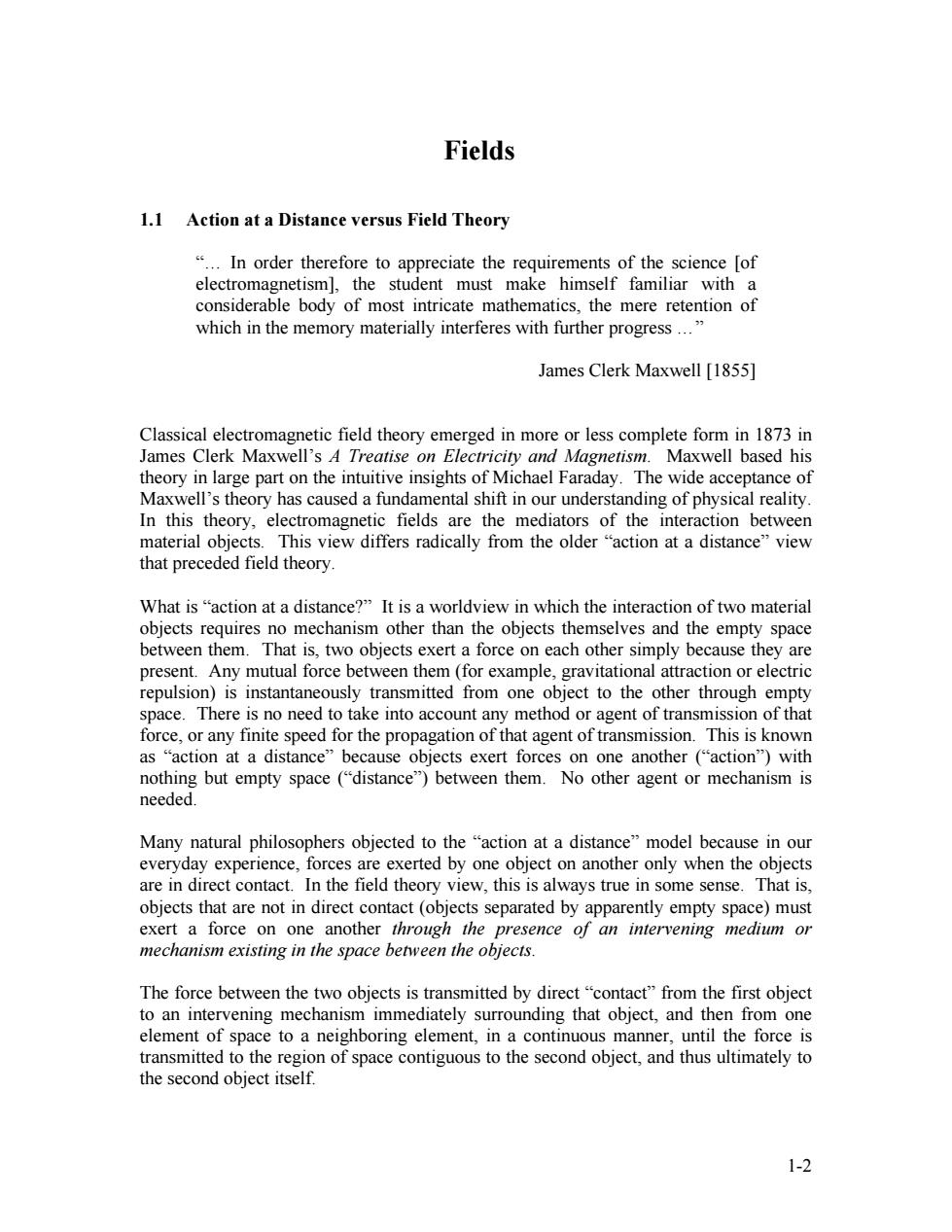正在加载图片...

Fields 1.1 Action at a Distance versus Field Theory ....In order therefore to appreciate the requirements of the science [of electromagnetism],the student must make himself familiar with a considerable body of most intricate mathematics,the mere retention of which in the memory materially interferes with further progress..." James Clerk Maxwell [1855] Classical electromagnetic field theory emerged in more or less complete form in 1873 in James Clerk Maxwell's A Treatise on Electricity and Magnetism.Maxwell based his theory in large part on the intuitive insights of Michael Faraday.The wide acceptance of Maxwell's theory has caused a fundamental shift in our understanding of physical reality. In this theory,electromagnetic fields are the mediators of the interaction between material objects.This view differs radically from the older "action at a distance"view that preceded field theory. What is"action at a distance?"It is a worldview in which the interaction of two material objects requires no mechanism other than the objects themselves and the empty space between them.That is,two objects exert a force on each other simply because they are present.Any mutual force between them(for example,gravitational attraction or electric repulsion)is instantaneously transmitted from one object to the other through empty space.There is no need to take into account any method or agent of transmission of that force,or any finite speed for the propagation of that agent of transmission.This is known as "action at a distance"because objects exert forces on one another ("action")with nothing but empty space ("distance")between them.No other agent or mechanism is needed. Many natural philosophers objected to the "action at a distance"model because in our everyday experience,forces are exerted by one object on another only when the objects are in direct contact.In the field theory view,this is always true in some sense.That is, objects that are not in direct contact (objects separated by apparently empty space)must exert a force on one another through the presence of an intervening medium or mechanism existing in the space between the objects. The force between the two objects is transmitted by direct "contact"from the first object to an intervening mechanism immediately surrounding that object,and then from one element of space to a neighboring element,in a continuous manner,until the force is transmitted to the region of space contiguous to the second object,and thus ultimately to the second object itself. 1-2Fields 1.1 Action at a Distance versus Field Theory “… In order therefore to appreciate the requirements of the science [of electromagnetism], the student must make himself familiar with a considerable body of most intricate mathematics, the mere retention of which in the memory materially interferes with further progress …” James Clerk Maxwell [1855] Classical electromagnetic field theory emerged in more or less complete form in 1873 in James Clerk Maxwell’s A Treatise on Electricity and Magnetism. Maxwell based his theory in large part on the intuitive insights of Michael Faraday. The wide acceptance of Maxwell’s theory has caused a fundamental shift in our understanding of physical reality. In this theory, electromagnetic fields are the mediators of the interaction between material objects. This view differs radically from the older “action at a distance” view that preceded field theory. What is “action at a distance?” It is a worldview in which the interaction of two material objects requires no mechanism other than the objects themselves and the empty space between them. That is, two objects exert a force on each other simply because they are present. Any mutual force between them (for example, gravitational attraction or electric repulsion) is instantaneously transmitted from one object to the other through empty space. There is no need to take into account any method or agent of transmission of that force, or any finite speed for the propagation of that agent of transmission. This is known as “action at a distance” because objects exert forces on one another (“action”) with nothing but empty space (“distance”) between them. No other agent or mechanism is needed. Many natural philosophers objected to the “action at a distance” model because in our everyday experience, forces are exerted by one object on another only when the objects are in direct contact. In the field theory view, this is always true in some sense. That is, objects that are not in direct contact (objects separated by apparently empty space) must exert a force on one another through the presence of an intervening medium or mechanism existing in the space between the objects. The force between the two objects is transmitted by direct “contact” from the first object to an intervening mechanism immediately surrounding that object, and then from one element of space to a neighboring element, in a continuous manner, until the force is transmitted to the region of space contiguous to the second object, and thus ultimately to the second object itself. 1-2